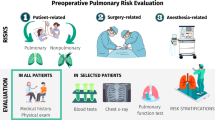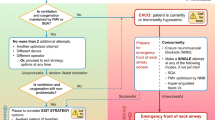Abstract
This retrospective review aims to evaluate the postoperative morbidity and mortality of 30 patients with Down syndrome who underwent adenotonsillectomy between June 2012 and December 2015 in a tertiary referral center. Mean age was 7.8 with a range of 3–12. There were 20 (66.6 %) male and ten (33.3 %) female patients. Mean follow-up was 23 months with a range of 7–43 months. 23 (76.6 %) of 30 patients had been operated due to obstructive tonsillar and adenoid hypertrophy, whereas seven (23.3 %) of them operated for chronic recurrent infections. All of the patients had undergone adenotonsillectomy operation; one patient had also bilateral tympanostomy tube insertion. Hospital stay was noted 1.3 days in average with a range of 1–3 days. Anesthetic complications of persistent bradycardia and postextubation respiratory difficulty occurred in two (6.6) patients. Patient who had intraoperative bradycardia necessitated intensive care unit stay and pacemaker implantation during follow-up. 3 (10 %) patients had late onset hemorrhage between days 7 and 10 and required intraoperative bleeding control. We did not experience any other morbidity and mortality except the abovementioned ones. In conclusion, adenotonsillectomy in patients with Down syndrome is a worthwhile operation with certain risks and these operations should better be performed by the tertiary referral centers which have the capacity to deal with the complications.
Similar content being viewed by others
References
Thottam PJ, Trivedi S, Siegel B, Williams K, Mehta D (2015) Comparative outcomes of severe obstructive sleep apnea in pediatric patients with Trisomy 21. Int J Pediatr Otorhinolaryngol 79(7):1013–1016. doi:10.1016/j.ijporl.2015.04.015 (Epub 2015 Apr 28)
Thottam PJ, Choi S, Simons JP, Kitsko DJ (2015) Effect of adenotonsillectomy on central and obstructive sleep apnea in children with down syndrome. Otolaryngol Head Neck Surg 153(4):644–648. doi:10.1177/0194599815587877 (Epub 2015 Jun 4)
Jacobs IN, Gray RF, Todd NW (1996) Upper airway obstruction in children with Down syndrome. Arch Otolaryngol Head Neck Surg 122(9):945–950
Bassell JL, Phan H, Leu R, Kronk R, Visootsak J (2015) Sleep profiles in children with Down syndrome. Am J Med Genet A 167A(8):1830–1835. doi:10.1002/ajmg.a.37096 (Epub 2015 Jun 23)
Bower CM, Richmond D (1995) Tonsillectomy and adenoidectomy in patients with Down syndrome. Int J Pediatr Otorhinolaryngol 33(2):141–148
Hamilton J, Yaneza MMC, Clement WA, Kubba H (2016) The prevalence of airway problems in children with Down’s syndrome. Int J Pediatr Otorhinolaryngol 81:1–4. doi:10.1016/j.ijporl.2015.11.027 (Epub 2015 Dec 07)
Ramia M, Musharrafieh U, Khaddage W, Sabri A (2014) Revisiting Down syndrome from the ENT perspective: review of literature and recommendations. Eur Arch Otorhinolaryngol 271(5):863–869. doi:10.1007/s00405-013-2563-4 (Epub 2013 May 21)
Merrell JA, Shott SR (2007) OSAS in Down syndrome: T&A versus T&A plus lateral pharyngoplasty. Int J Pediatr Otorhinolaryngol 71(8):1197–1203 (Epub 2007 May 29)
Shete MM, Stocks RM, Sebelik ME, Schoumacher RA (2010) Effects of adeno-tonsillectomy on polysomnography patterns in Down syndrome children with obstructive sleep apnea: a comparative study with children without Down syndrome. Int J Pediatr Otorhinolaryngol 74(3):241–244. doi:10.1016/j.ijporl.2009.11.006 (Epub 2010 Jan 25)
Shott SR, Donnelly LF (2004) Cine magnetic resonance imaging: evaluation of persistent airway obstruction after tonsil and adenoidectomy in children with Down syndrome. Laryngoscope 114(10):1724–1729
Baldassari CM, Kepchar J, Bryant L, Beydoun H, Choi S (2012) Changes in central apnea index following pediatric adenotonsillectomy. Otolaryngol Head Neck Surg 146(3):487–490. doi:10.1177/0194599811428118 (Epub 2011 Nov 10)
Ferri R, Curzi-Dascalova L, Del Gracco S, Elia M, Musumeci SA, Stefanini MC (1997) Respiratory patterns during sleep in Down’s syndrome: importance of central apnoeas. J Sleep Res 6(2):134–141
Skatrud JB, Dempsey JA, Badr S, Begle RL (1988) Effect of airway impedance on CO2 retention and respiratory muscle activity during NREM sleep. J Appl Physiol 65(4):1676–1685
Goldstein NA, Armfield DR, Kingsley LA, Borland LM, Allen GC, Post JC (1998) Postoperative complications after tonsillectomy and adenoidectomy in children with down syndrome. Arch Otolaryngol Head Neck Surg 124(2):171–176. doi:10.1001/archotol.124.2.171
Roodman S, Bothwell M, Tobias JD (2003) Bradycardia with sevoflurane induction in patients with trisomy 21. Paediatr Anaesth 13(6):538–540
Bai W, Voepel-Lewis T, Malviya S (2010) Hemodynamic changes in children with Down syndrome during and following inhalation induction of anesthesia with sevoflurane. J Clin Anesth 22(8):592–597. doi:10.1016/j.jclinane.2010.05.002
Welinder NR, Hoffmann P, Håkansson S (1997) Pathogenesis of non-traumatic atlanto-axial subluxation (Grisel’s syndrome). Eur Arch Otorhinolaryngol 254(5):251–254
Bhattarai B, Kulkarni AH, Kalingarayar S, Upadya MP (2009) Anesthetic management of a child with Down’s syndrome having atlanto axial instability. JNMA J Nepal Med Assoc 48(173):66–69
Harley EH, Collins MD (1994) Neurologic sequelae secondary to atlantoaxial instability in Down syndrome. Implications in otolaryngologic surgery. Arch Otolaryngol Head Neck Surg 120(2):159–165
Acknowledgments
This study was not funded.
Author information
Authors and Affiliations
Corresponding author
Ethics declarations
Conflict of interest
The authors have no potential conflicts of interest.
This article does not contain any studies with human participants or animals performed by any of the authors. Study includes only retrospective chart review without any patient identifiable, so no patient participation and informed consent were required.
Additional information
This work was done in Ministry of Health Marmara University Education and Research Hospital.
Rights and permissions
About this article
Cite this article
Yumusakhuylu, A.C., Binnetoglu, A., Demir, B. et al. Is it safe to perform adenotonsillectomy in children with Down syndrome?. Eur Arch Otorhinolaryngol 273, 2819–2823 (2016). https://doi.org/10.1007/s00405-016-4012-7
Received:
Accepted:
Published:
Issue Date:
DOI: https://doi.org/10.1007/s00405-016-4012-7




